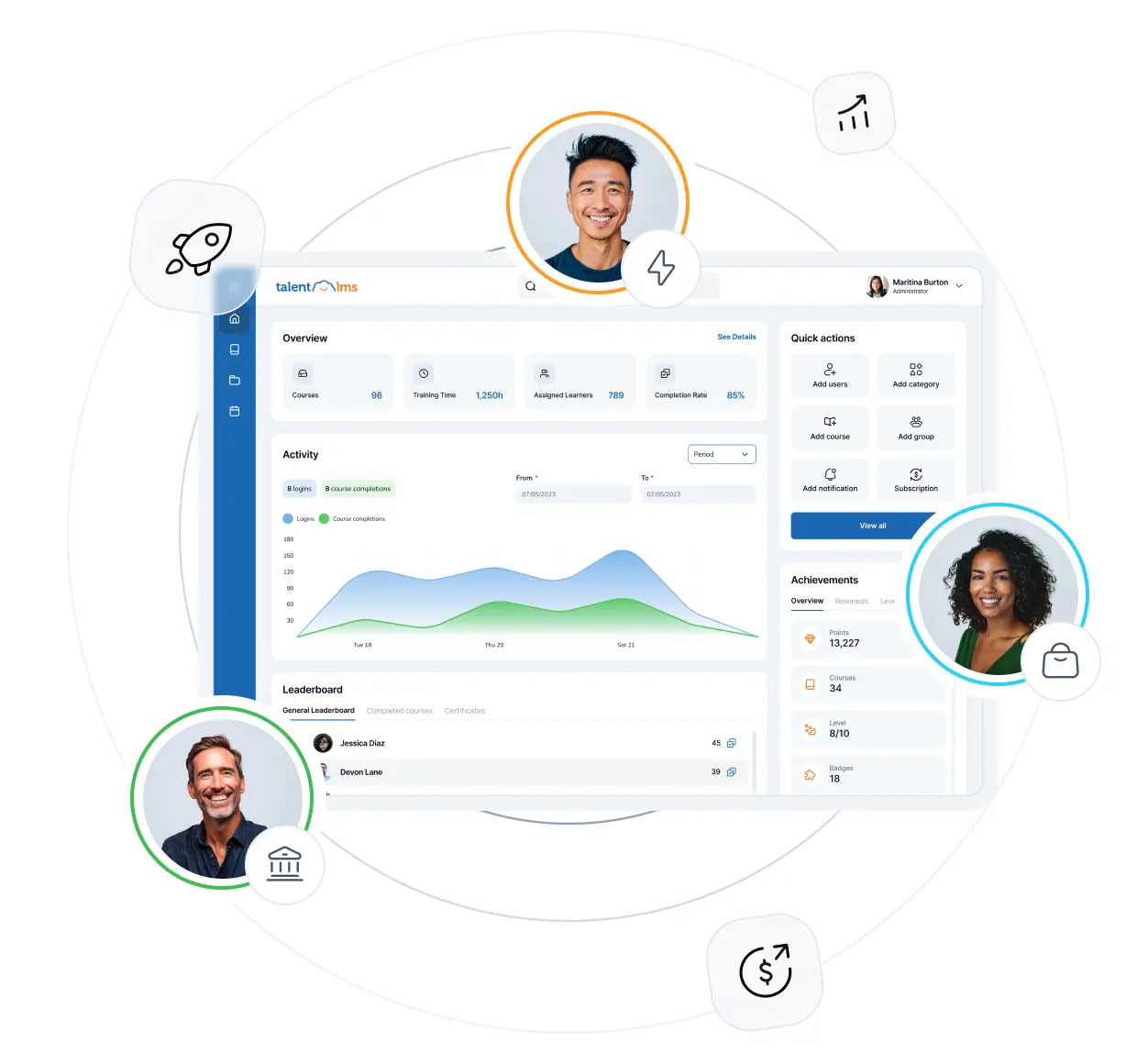Product knowledge training—often treated like the corporate equivalent of learning which fork to use at a banquet: essential yet sometimes fumbled. It’s much more than just a task for onboarding or an outdated internal wiki.
Instead, it’s the very bedrock upon which you build confident sales pitches, informed customer service flourishes, and ultimately, how you secure your products’ success in the marketplace.
In this A–Z guide, we’ll cover how to build great training modules, pick the right way to deliver them, measure their impact, and make sure the whole company benefits from the training.
What is product knowledge training?
At its heart, product knowledge training is about methodically educating employees, partners, and customers about the ins and outs of a company’s products or services.
For employees and partners, it’s the essential working knowledge they need to confidently sell, support, and deliver the product. While for customers, it’s the know-how they need to adopt it smoothly and get the most value from it.
However, it goes far beyond just memorizing features. It’s about real understanding of how the product functions and what problems it solves.
Why is product knowledge training important?
There are a few reasons for why product knowledge training is important.
Increased sales and conversions
Salespeople who genuinely know their products inside and out don’t just rattle off features, they explain the actual value based on the customer pain points.
They can handle objections confidently, clearly show how the product stands out from competitors (for reasons beyond just the price tag), and present solutions convincingly.
This capability often leads straight to quicker sales cycles and more successfully closed deals.
On the flip side, sales team members obviously unsure of the details don’t exactly inspire confidence or quick decisions.
Stronger customer trust
Customers are remarkably good at sensing when someone’s bluffing or unsure. When your staff provides clear, confident answers and show they truly understand the product, it builds trust.
Research shows that 94% of customers say that good service experiences make them more likely to buy again. This means that always being accurate and helpful builds stronger relationships and encourages loyalty.
Unclear, conflicting, or evasive answers frustrate customers, break trust, and cost you sales.
Faster onboarding
New team members joining without a solid grasp of the products often spend weeks, even months, feeling unproductive and constantly trying to catch up. A well-structured product training program significantly cuts down this ‘getting up to speed’ time.
Additionally, organizations with strong onboarding processes see new-hire retention improve by as much as 82% and productivity lift by over 70%.
Improved employee confidence and retention
It’s incredibly stressful and demoralizing for employees to constantly feel unsure about the very products they’re supposed to work with every day. Good training replaces that gnawing uncertainty with genuine confidence.
Employees who feel capable and well-equipped to handle customer queries or technical challenges are naturally more satisfied in their jobs.
In fact, a striking 64% of employees report they would stay longer with a company if it invested in their learning and development.
Staff are less likely to look for a new job if they feel skilled, supported, and effective, which helps reduce the high costs of replacing experienced team members.

Types of product knowledge training
A product knowledge training program changes quite a bit depending on exactly who needs the information and how they can best soak it up.
Generally, we can group the types by who they’re aimed at and how they’re delivered.
Internal product training (employees, support, sales)
First, there’s internal training, focused squarely on the company’s own team members. This includes staff across different departments, although sales and customer support teams usually receive the most in-depth versions.
The main goal is to build a strong understanding and confidence.
We want to develop real product experts who can explain the value clearly, handle difficult customer questions easily, and hopefully avoid that wide-eyed, panicked look when put on the spot.
External product training (partners, resellers, customers)
Next, there’s training designed for important groups outside the company. This covers key channel partners and resellers who need to know enough about the products or services to represent and sell them effectively.
While still comprehensive, their training might lean more towards hitting the main selling points and differentiators, rather than diving into every single technical specification.
Sometimes, this type of training is also given directly to customers, especially for more complex products. A little structured guidance helps them get the most value (and often leads to fewer customer complaints later).
Type of training based on the delivery method
Apart from who the training is for, the delivery methods themselves create different types.
There’s the age-old distinction between gathering everyone in a physical room (face-to-face) versus the flexibility offered by learning management systems (LMS).
The timing and pace also differ, ranging from self-study modules people tackle whenever they have time, to live, scheduled classes led by an instructor (often called ILT).
Within these broad approaches, there are many new formats being used, like short, focused microlearning lessons (such as TalentLibrary), or blended learning to ensure a good balance between self-led and guided learning.
How to deliver effective product knowledge training (+ tips)
The easy part is to know the ‘what’ and ‘why’ of product knowledge training sessions. The real work—and where you see actual results—is in designing and delivering it correctly.
Let’s walk through the steps.
1. Identify your goals and audience
Before you even think about creating content, get crystal clear on two key things:
- What results should this product knowledge training produce?
- Who exactly needs to learn this?
Knowing your target helps you focus on the right product training objectives.
Customizing the training information is just as essential.
Sales reps need ways to handle competitor questions, while support staff need the nitty-gritty details to fix tricky problems. Different people need different things explained in ways that make sense for their jobs.
Tip
Focus your goals on what people should do, not just what they should know. Instead of aiming for staff to “understand the update”, aim for “be able to show a customer the three main benefits of the update”.
2. Choose the right format and tools
With clear goals and your target audience in mind, picking the right way to deliver the training becomes much simpler.
A geographically dispersed team often benefits from online, self-paced learning modules hosted on an learning management system for consistent delivery and tracking.
On the other hand, complex topics involving intricate skills might be better served by blended learning approaches that combine online theory with interactive workshops (virtual or in-person).
You’ll need to compare the necessary technology required to deliver the training.
On the contrary, an LMS, like TalentLMS, can manage content, deliver training, and track completion. They integrate with conferencing tools and HRIS systems, and acts as a central, well-organized training hub that also serves as a knowledge base.
Tip
Don’t get distracted by the latest fancy training tech just because it’s new. Choose formats and tools that help you learn, fit the information you’re sharing, and are easy for your audience to use.
3. Create or source engaging content
Reading long lists of technical specs isn’t most people’s idea of fun.
To make product knowledge memorable, the content needs to grab and hold attention to make product knowledge memorable. To do this, use real-life examples, customer satisfaction stories, or short case studies that show how the product helps solve actual problems.
Mix things up to keep people interested and fit different ways of learning. Use clear text, helpful diagrams, short videos, interactive quizzes, and maybe even gamification elements.
Tip
Keep it relevant. People quickly forget abstract ideas, but practical examples that they can immediately connect to their work tend to stick much better.
To test your sales team’s knowledge, ensure they know the answer to these product knowledge questions.
4. Train and track progress
Aside from creating and delivering training, you’ll also need to track progress effectively. Measuring training effectiveness comes down to a number of tangible and non-tangible KPIs, including:
- Course completion rates
- Pass / Fail rates
- Training time
- Employee retention
- Cost per employee
- Course rating survey
Tip
Check for understanding and the ability to apply the knowledge, not just memorizing. To ensure real retention, go beyond completion rates and look at how skills translate into real outcomes, like closed sales deals or improved customer support. (Here’s a guide to track progress and measure training ROI.)
5. Reinforce and refresh regularly
People forget things quickly if they don’t use the information regularly. It’s just how brains work (often called the ‘forgetting curve’).
On top of that, products change, new features appear, and competitors make moves.
You need a plan to keep the knowledge fresh. Think about regular short updates via quick online modules, simple quizzes, easy-to-find checklists or job aids, and keeping that central knowledge base completely up-to-date and simple to search.
Tip
Build knowledge retention with refreshers embedded into the daily routine. Things like quick reference guides available right in your sales training software, short ‘how-to’ videos linked from common questions, or quick updates shared in team meetings are often more effective and less disruptive than big, infrequent retraining sessions.
Common product knowledge training pitfalls to sidestep
Even when aiming to develop the best product knowledge training, it’s easy to stumble.
Watch out for these common errors:
- Using the same training for everyone (sales, support, partners) and ignoring their different needs and viewpoints.
- Dumping too much technical detail on learners all at once without explaining what’s most important leaves them overwhelmed.
- Talking only about what the product does and not explaining why customers should care (the benefits and problems it solves).
- Presenting information without giving people chances to practice using it through realistic examples or role-playing.
- Treating training as a one-off task with no plan for follow-up, refreshers, or updates when the product changes.
- Not asking learners what they thought worked, what didn’t, and how the training could be better next time.
- Letting training materials get old and inaccurate because the product or market has changed.
- Relying only on information-heavy slides or dense documents makes learning feel like a chore.
The role of an LMS in product knowledge training
Training might start with using shared documents or email attachments. But effective product knowledge training benefits a lot from a dedicated LMS.
An LMS provides key benefits like structure, consistency, centralization and most importantly, scalability for long-term growth, making it a modern-day must-have.
Here are some key features that help your product knowledge training:
- Branches (or sub-portals) let you set up separate, focused learning areas for different groups, keeping internal teams separate from external partners. You can manage it all from one place, but give each group the training that fits their specific needs.
- AI content creation features speed up the creation and updating of training content, which helps make sure the information stays current without piling too much extra work on your L&D team.

- Integrations link user information with other company systems, like your HR platform for employee details or LMS for channel partner training information, cutting down on manual work.
- Detailed reporting show more than just who finished the course. You can track how engaged learners are, how well they do on tests, and their overall progress. This gives you real numbers to help you judge the training’s effectiveness and figure out how much training you spent.
Top LMS options
With all this in mind, let’s look at the top LMS options online to help you see what’s possible and what to expect.
Putting product training first
Putting real effort into a product knowledge training plan is the foundation for building truly capable teams. This built-up knowledge and skill lead to more confident staff interactions with customers, smoother day-to-day work, and better overall results for the business.
In the end, giving teams real, hands-on understanding is what separates companies that truly know their stuff from those that are just vaguely familiar with it—a difference obvious to customers and competitors.
Building this level of skill is what helps you stand out from the rest and sets your team up for success.
| Tags: Product training


